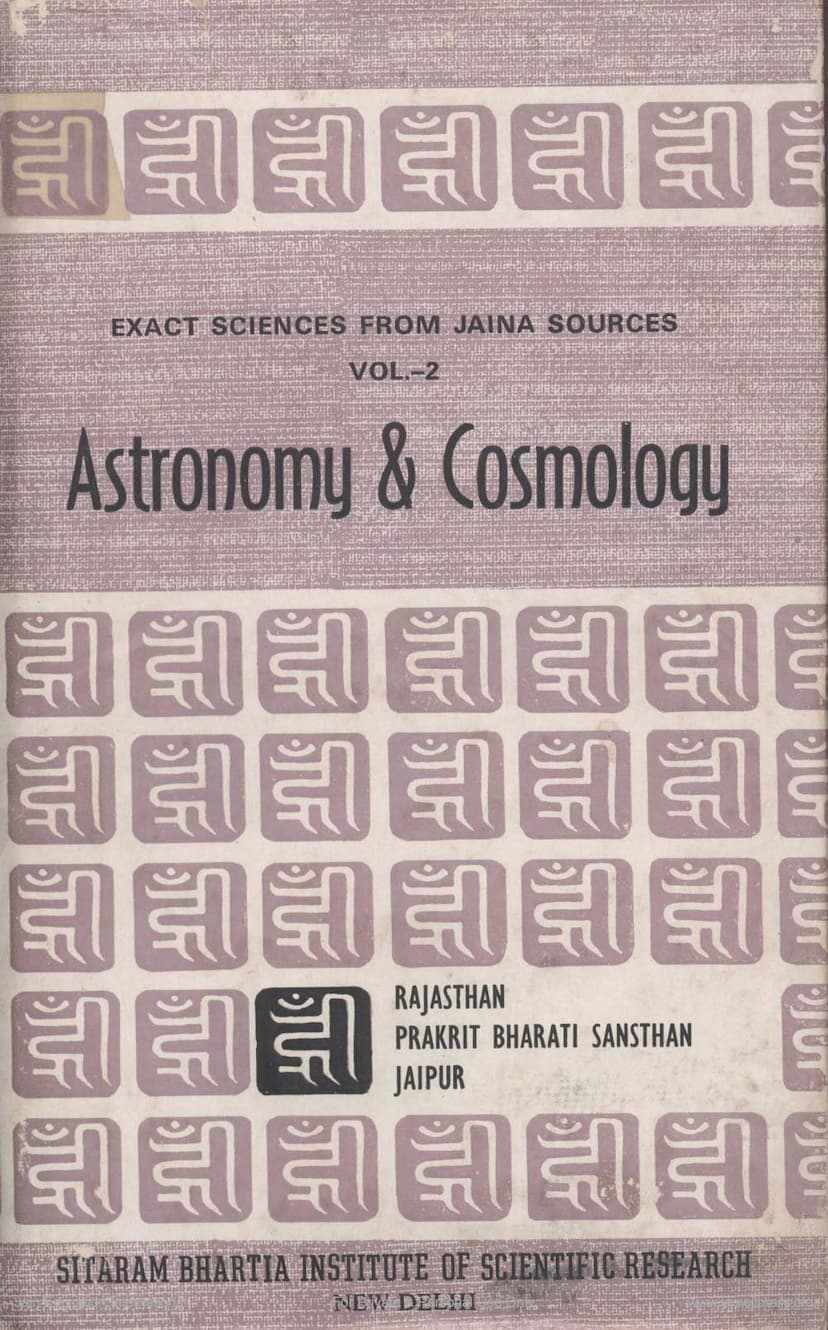Astronomy And Cosmology
Added to library: September 1, 2025

Summary
This document is the second volume of a series titled "Exact Sciences from Jaina Sources" by L. C. Jain. This specific volume, "Astronomy and Cosmology," explores the contributions of Jainism to these scientific fields.
Key Themes and Content:
The book is structured to provide a comprehensive overview of Jaina astronomical and cosmological concepts, comparing them with other ancient and modern scientific traditions.
-
Introduction: It highlights the "Science Awakening" that occurred around the time of Vardhamana Mahavira and Gautama Buddha, emphasizing the Jaina school's significant contributions to astronomy and cosmology. It also situates Jaina thought within a broader historical context, mentioning figures like Copernicus, Galileo, Newton, and Einstein, and touches upon the challenges faced by scientists for their discoveries.
-
Jaina Cosmos: The Jaina cosmology is described as finite and centrally located within infinite space. The universe (Lokākāśa) is characterized by six eternal fluents: souls (jiva), matter (pudgala), time (kāla), aether (dharma), anti-aether (adharma), and space (ākāśa). The concepts of space-points (pradeśa) and time-instants (samaya) are introduced as fundamental units. The book discusses the Jaina understanding of the universe's structure, including the divisions into upper, intermediate, and lower universes, and the concept of karmic relations influencing dynamical laws.
-
Technical Terms: The text explains modern astronomical terms and celestial diagrams to facilitate comparison with ancient Jaina literature, noting differences in frames of reference.
-
Source Material: It traces the historical evolution of astronomy from the Vedic era through the Vedānga Jyotișa and into the Astro-theoretical era, emphasizing the Jaina tradition. It lists key Jaina texts related to mathematics, astronomy, and cosmology, spanning from early canonical works to later commentaries and the literature of both Svetambara and Digambara schools. Prominent Jaina scholars and their contributions are also mentioned.
-
Cosmological Concepts: This section delves into fundamental Jaina cosmological ideas, particularly the unit of measurement called "rajju" (rope). It discusses various definitions of rajju and attempts to rationalize its immense scale by comparing it with modern cosmological models and scientific theories. The volume of the universe, cosmic periods, cycles, and concepts like palya and sāgara (units of time) are elaborated. The intricate Jaina concepts of transmigration and the "cycle of phase" (bhāva parāvartana) are also detailed. The book also touches upon the philosophical principles underpinning Jaina cosmology, such as the concept of "least time" and "least path."
-
Astronomical Concepts: The text analyzes Jaina astronomical concepts, including the precession of equinoxes, and compares calendars, noting similarities between the Vedānga Jyotișa and Prakrit texts. It highlights the Jaina addition of the "Abhijit" nakṣatra to the traditional 27. The dating of the Jaina canon is discussed based on astronomical incidences. The structure of the Jaina calendar (Pañcānga) is explained, detailing tithi, vara, and nakṣatra. The graduation of the celestial sphere within the Jaina system is presented, with detailed tables showing the celestial parts, durations, and velocities associated with various constellations.
-
Kinematics of Astral Bodies: This chapter examines the motion of celestial bodies as described in Jaina texts, comparing them with systems from China, Greece, and Babylonia. It discusses the Jaina nakṣatra system, its potential connections to the zodiac, and the mathematical descriptions of planetary and lunar motion found in texts like the Candraprajñapti and Tiloyapaņņatti. The concept of "shadow planets" and their possible role in calculations is also explored. The relative motions of the sun, moon, and stars are detailed, along with their celestial part divisions per muhūrta, and the remarkable accuracy of some Jaina calculations is noted.
-
Rationalization of Yojana: The book discusses the measurement unit "yojana" as used in Jaina texts, its derivation, and its different types (ātmāṅgula, utsēdhāṅgula, pramāṇāṅgula). It compares the Jaina yojana with the Chinese "li" and explores various scholarly attempts to rationalize and correlate these ancient measures with modern scientific units and astronomical parameters like the obliquity of the ecliptic.
-
Calendrical Yuga System: The Jaina approach to calendrical yugas (cycles) is presented, noting its unique starting point with the Abhijit nakṣatra. The complex interrelationships between different types of years (solar, lunar, nakṣatra, etc.) within these cycles are explained.
-
Astronomical Theory: The final chapter categorizes astronomical theories into "principle theories" and "constructive theories," drawing parallels with Einstein's classifications. It then examines where the Jaina astronomical theory fits within this framework, noting its empirical basis, abstractive methods, and the evolution of its concepts, particularly in relation to eclipse prediction and the development of epicycles. The influence of Jaina astronomical thought on later Siddhāntic astronomy is also touched upon.
Overall Significance:
The book "Astronomy and Cosmology" by L. C. Jain aims to showcase the depth and sophistication of Jaina contributions to astronomy and cosmology. It highlights how these ancient Indian traditions developed complex mathematical models and cosmological frameworks, often anticipating or paralleling discoveries in other civilizations and later scientific advancements. The work underscores the Jainas' meticulous observation, calculation, and philosophical integration of astronomical knowledge.